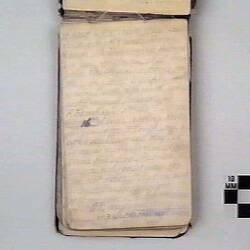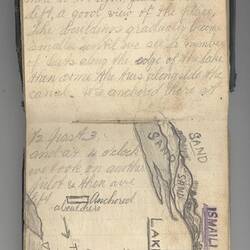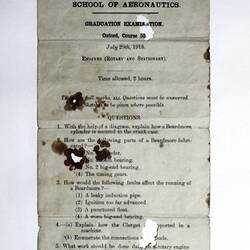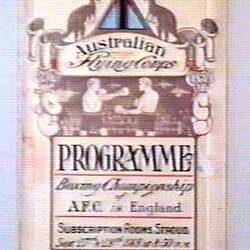Summary
World War I diary written by Private Alan Horner, no. 2033, H Company, 6th Battalion, 2nd Infantry Brigade, 1st Division AIF, September 1914 - October 1915. The diary includes details regarding service in Gallipoli, and a sketch of Ismali, Egypt, including Lake Timsah.
Alan Horner was born in Castlemaine, Victoria, and became a grocer. He joined the Cadets as a youth and was serving in Area 66 as a 2nd Lieutenant when he enlisted in the AIF at the age of 18, on 11 September 1914. He embarked from Australia on 21 October 1914. He joined his unit at Gallipoli on 15 May 1915, just 20 days after the first landing. He was wounded on 8 August, and on 10 August was admitted to the No.2 Field Ambulance Dressing Station suffering 'debility and shock'. He was transferred to a casualty clearing station, and sent to England by ship. He was admitted to Wandsworth Hospital, England, on 23 August suffering a 'disability' that was 'not stated as being serious'. He remained in England from that point on, and in September 1916 was attached to the AAPC (Australian Army Pay Corps). In January 1918 he was reprimanded for the offence of being 'improperly dressed', failing to wear 'chevrons and distingushing colours'. Weeks later he was admitted to hospital again, this time with influenza (just prior to the 'Spanish Flu' pandemic). In May 1918 he began a cadetship with the Australian Flying Corps, and in June was an RAF cadet, 'training as flying officer (Pilot)'.
Horner was a 2nd Corporal when repatriated to Australia from overseas in December 1918. He was discharged from military service on 23 March or 13 May 1919 (some variation in dates of discharge recorded) - due to being medically unfit due to an accident while not on military service. He later applied for a War Service home.
Physical Description
Hand-written diary with black cover, hinged at the top, with elastic strap to hold closed (now stretched and broken). Cover has the appearance of leather, but now has significant losses, and the substrate is visible in places. Lined off-white pages, mostly written in pencil. May include marks made with an indelible pencil, which releases a purple dye when wetted. Includes a sketch of Ismali, Egypt, including Lake Timsah.
Significance
Personal diaries provide a valuable insight into the daily life in the Australian armed forces. Some diarists record the mundane routines of daily life in military camps, or ports visited during voyages on transport ships; others provide graphic details of battles and medical treatments. Welcome letters and parcels from home are described, and friendships are recorded. Many soldiers complain about the food, or record welcome or festive meals such as Christmas. The diaries show many of the ways servicemen and women coped with the discipline, stress and tragedy of war.
More Information
-
Collection Names
Military Memorabilia Collection, Returned and Services League (RSL) Collection
-
Collecting Areas
-
Acquisition Information
Donation & Subsequent Transfer from Victorian Branch, Returned & Services League of Australia Limited (RSL), Mrs Yvonne Van Veen, Mar 1987
-
Author
-
Classification
-
Category
-
Discipline
-
Type of item
-
Overall Dimensions
9.5 cm (Width), 1.8 cm (Depth), 15.4 cm (Height)
-
References
The National Archives of Australia holds Alan Horner's service records - Series accession number B2455, Barcode 5831737.
-
Keywords
Wars & Conflicts, World War I, 1914-1918, Making History - War Diaries and Correspondence







